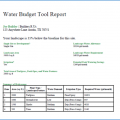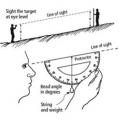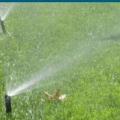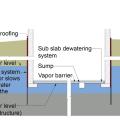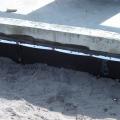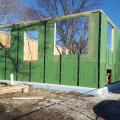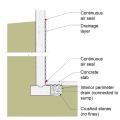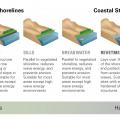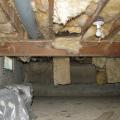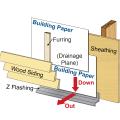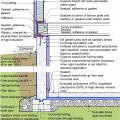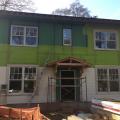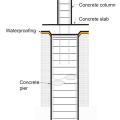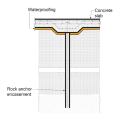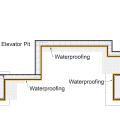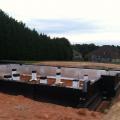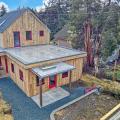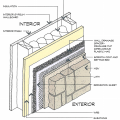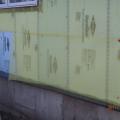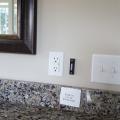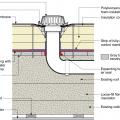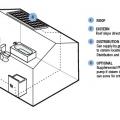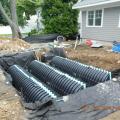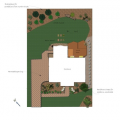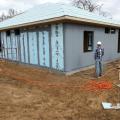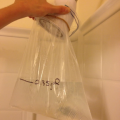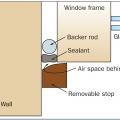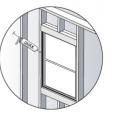Showing results 1 - 50 of 688
A method for preventing waterproofing issues at the intersection of a concrete pier, concrete retaining wall, and concrete slab.
An example of the water budget tool report for determining a home's landscaping irrigation needs.
Impervious surfaces like patio slabs, sidewalks, and driveways that are within 10 feet of the home should slope away from the house.
Place plants at least 18 inches from the building's walls and foundation and direct irrigation water to spray away from the structure.
The “perimeter cutoff and dewatering” approach can be used to control groundwater in cases where the building foundation is below the groundwater table.
A coated OSB product with taped seams covers the walls to serve as both sheathing and weather-resistant barrier.
A common method of addressing significant groundwater leakage in the foundation is to line the entire foundation assembly, including the slab, with a drainage layer.
A common method of addressing significant groundwater leakage in the foundation is to line the interior perimeter of the foundation with a drainage layer.
A continuous layer of polyethylene covers the crawlspace floor and is attached to the wall with wood nailing strips
A continuum of green (soft) to grey (hard) shoreline stabilization techniques used to mitigate the effects of erosion
A dimpled plastic water barrier protects the insulated concrete form basement walls and carries any ground water down the walls to the footing drain to minimize the opportunity for water intrusion and frost heave.
A dimpled rain mat and perforated drain pipe provide drainage around the basement foundation.
A drainage plane is created behind lap siding by installing furring strips on the exterior walls over house wrap which is overlapped and taped at all seams to serve as an air and water barrier.
A drywell, shown here used for downspout catchment, can also be used to receive water from a French drain.
A French drain contains a perforated drain pipe wrapped in rock and landscape fabric.
A layer of pea gravel or crushed stone, 4 inches thick and sloped 5%, provides a pest-resistant ground break around the perimeter of a slab foundation
A layer of pea gravel or crushed stone, 4 inches thick and sloped 5%, provides a pest-resistant ground break around the perimeter of a basement foundation
A liquid-applied water barrier covers the walls, serving as a drainage plane, air and vapor barrier, and secondary window flashing beneath the rigid foam that will be installed next.
A mesh plastic rainscreen product separates the coated OSB from the siding, providing a drainage space and ventilation gap.
A method for preventing waterproofing issues at the intersection of a concrete column, concrete slab, and concrete pier.
A method for preventing waterproofing issues at the intersection of a concrete slab and a rock anchor.
A method to ensure waterproofing continuity across the elevator pit of a multistory multifamily building.
A moisture meter verifies that the moisture of the framing is below the recommended 18%.
A paint-on flashing is used around the windows and doors for seamless water protection.
A paint-on waterproofing covers the exterior and tops of the concrete block foundation walls and piers to block moisture moving up through the concrete, while foil-faced R-13 insulation lines the inside surface of the exterior walls.
A permeable ground surface of crushed stone and vegetation helps control runoff on this small lot in the often rainy Pacific Northwest.
A piece of siding is used as sill extension and to provide slope in the opening for the window, which is deeper because exterior rigid foam has been added
A plastic fiber drainage mat rainscreen provides uniform support for the siding and allows moisture to flow horizontally and diagonally in addition to vertically.
A plastic mesh rain screen is installed over the rigid foam to provide an air gap behind the exterior cladding allowing for drainage and drying.
A push button operates the on-demand hot water circulation pump in this master bathroom.
A roof drain is installed in an existing flat roof retrofitted with above-deck rigid foam insulation that is integrated with new air and water control layers
A sprayer-applied waterproofing covers the grout-filled top course of concrete foundation blocks to prevent moisture migration from the ground into the framing.
A storm water management system channels rainwater to retention chambers buried in the front yard.
A strip of OSB sheathing is installed along the perimeter when retrofitting a flat roof with a parapet
A swale and berm can be installed together across a slope to slow the downhill flow of water.
A thoughtful landscaping plan can increase the beauty and functionality of outdoor spaces while reducing water usage.
A water-resistant membrane that takes the place of house wrap is sprayed is painted over seams and window framing then sprayed over the entire wall to provide a weather-resistant air barrier.
A WaterSense-labeled showerhead is tested to ensure a flow of ≤ 0.35 gallons in a 10-second test.
Adding planted terraces to a sloped yard can slow down runoff and reduce erosion

